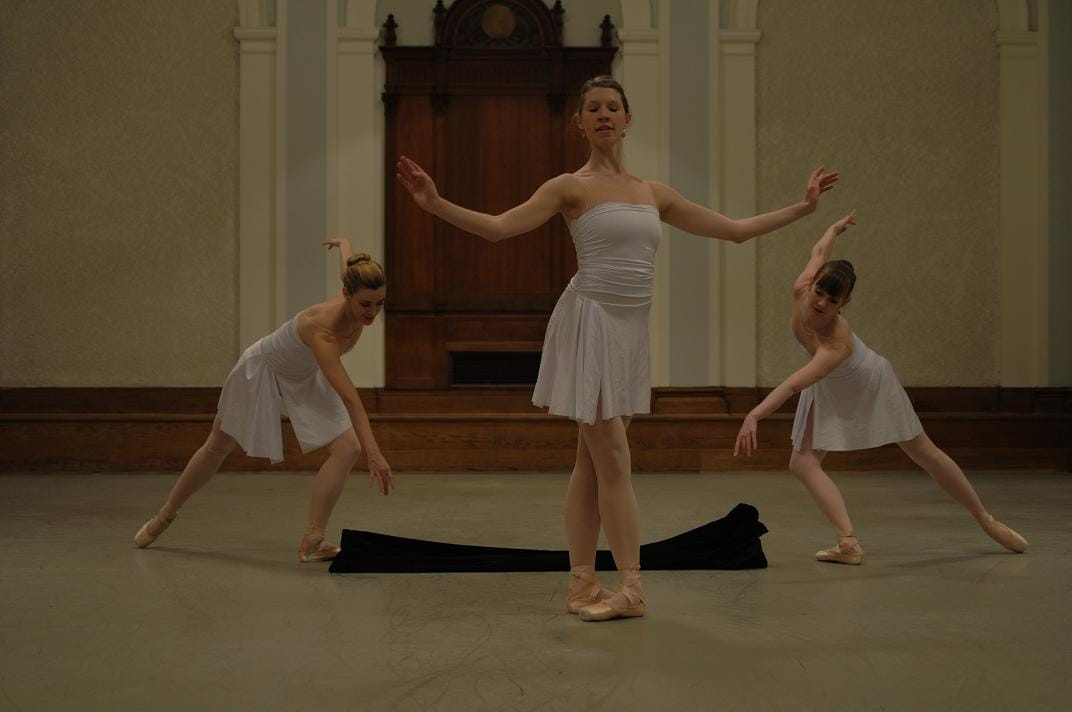Small Packages

"Symmetry", "Moments", "104º Fahrenheit", "Allegretto, Innocente", "Five Songs for Piano"
New Chamber Ballet
City Center Studio 4
New York, NY
November 19, 2010
The New Chamber Ballet is, it seems, born from limitations--live music is too expensive? Use works with only a piano and a violin. Stage space is prohibitive? Perform in a studio without scenery or a backstage. Flashy male virtuosity is all the rage? Choreograph introspective, contemplative works for women. The director and chief choreographer, Miro Magloire, introduced each work with a clarity so at odds with the current jargon, and the dancers strolled into the performance space through the audience, giving the evening an informal, but not overly casual, feel.
The evening opened with the premiere of Magloire's "Symmetry" to two violin sonatas by Handel. There were two dancers, Alexandra Blacker and Victoria North, and they got quite a workout. At times, they had the air of two nymphs playing on a river bank (the simple but elegant costumes, by Candice Thompson, evoked Greek tunics) and there was a charming impromptu feel to much of the dancing. It did go on a bit too long, though, and at times tended to be repetitious--one sonata would probably have been enough.
The second work, "Moments", a solo for Lauren Toole, was much more concise and focused. Though there was one dancer, the music, a violin solo by Salvatore Sciarrino, was just as important. The music was eerie, sharp, and piercing, and the work had the slightly macabre feel of an E. T. A. Hoffman story, as if the music were controlling the dancer. Toole's dancing was powerful and centered and this was an unusual and haunting work.
Magloire is a trained musician, and at 17 was taking graduate level compositions classes in his native Germany. (He came to dance late). He introduced "104º Fahrenheit" by explaining that, though he didn't use his own compositions, this short piece was an exception, choreographed just so people wouldn't keep asking him why he used other works; however, he said, he quite liked it. And so did I. The music, for piano, comes in short, sharp bursts, and the choreography, for Alexandra Blacker, Elizabeth Brown, and Madeline Deavenport, is somewhat reminiscent of Balanchine's Choleric. Magloire's "Allegretto, Innocente", to two piano sonatas by Joseph Haydn, was somewhat reminiscent of his opening work; it would probably have worked better on a different program, though it, too, was one sonata too long. It had an approximation of scenery, for the three dancers (Toole, North, and Deavenport) manipulated sheets of black velvet and showed off their elegantly draped arms.
Emery LeCrone's "Five songs for Piano" (to Mendelssohn's "Songs Without Words") closed the program and featured all five dancers. It was originally done for the Columbia Ballet Cooperative, and the elegant Victoria North appeared in both performances. Without the atmospheric lighting of the original, it lost some of the mysterious ritualistic feel, and, for me, seemed less interesting. LeCrone, in this piece, doesn't show Magloire's musical sensitivity, and the slightly awkward, knock kneed choreography seemed at odds with the limpid beauty of the music. The dancers, though, were thrilling.
copyright © 2010 by Mary Cargill



